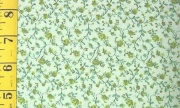Difference between revisions of "Calico"
Jump to navigation
Jump to search
m (Text replace - "== Authority ==" to "== Sources Checked for Data in Record ==") |
m (Text replace - "\[http:\/\/cameo\.mfa\.org\/materials\/fullrecord\.asp\?name=([^\s]+)\s(.*)\]" to "$2") |
||
| Line 2: | Line 2: | ||
== Description == | == Description == | ||
| − | An inexpensive, plain weave [ | + | An inexpensive, plain weave [[cotton|cotton]] fabric with a printed design on one side. Calico cloth originated in Calicut, India, by the 11th century and is one of the oldest cotton cloths. Early examples of calico were [[resist-dyed%20textile|resist-dyed]] or stamped to produce colored designs on a light background. The term 'calico' now refers to any cotton fabric printed with a small repetitive designs in one or more colors. In Britain, the term 'calico' is also used for a plain white cotton fabric, similar to [[muslin|muslin]], but slightly heavier. Calico is used for saris, dresses, aprons, and occasional bookcovers. |
[[File:calicooogreenf5.jpg|thumb|Calico cotton print]] | [[File:calicooogreenf5.jpg|thumb|Calico cotton print]] | ||
Revision as of 13:02, 9 May 2016
Description
An inexpensive, plain weave Cotton fabric with a printed design on one side. Calico cloth originated in Calicut, India, by the 11th century and is one of the oldest cotton cloths. Early examples of calico were resist-dyed or stamped to produce colored designs on a light background. The term 'calico' now refers to any cotton fabric printed with a small repetitive designs in one or more colors. In Britain, the term 'calico' is also used for a plain white cotton fabric, similar to Muslin, but slightly heavier. Calico is used for saris, dresses, aprons, and occasional bookcovers.
Synonyms and Related Terms
Calicut cloth; calicot (Fr.); calicot (soort katoenstof) (Ned); bedrukte katoenstof (Ned);
Sources Checked for Data in Record
- Rosalie Rosso King, Textile Identification, Conservation, and Preservation, Noyes Publications, Park Ridge, NJ, 1985
- Matt Roberts, Don Etherington, Bookbinding and the Conservation of Books: a Dictionary of Descriptive Terminology, U.S. Government Printing Office, Washington DC, 1982
- Edward Reich, Carlton J. Siegler, Consumer Goods: How to Know and Use Them, American Book Company, New York City, 1937
- G.S.Brady, Materials Handbook, McGraw-Hill Book Co., New York, 1971 Comment: p. 247
- Hermann Kuhn, Conservation and Restoration of Works of Art and Antiquities, Butterworths, London, 1986
- Encyclopedia Britannica, http://www.britannica.com Comment: "Calico." Encyclopædia Britannica. 10 Aug. 2004 .
- Kurt Wehlte, The Materials and Techniques of Painting, Van Nostrand Reinhold Co., New York, 1975
- Art and Architecture Thesaurus Online, http://www.getty.edu/research/tools/vocabulary/aat/, J. Paul Getty Trust, Los Angeles, 2000

